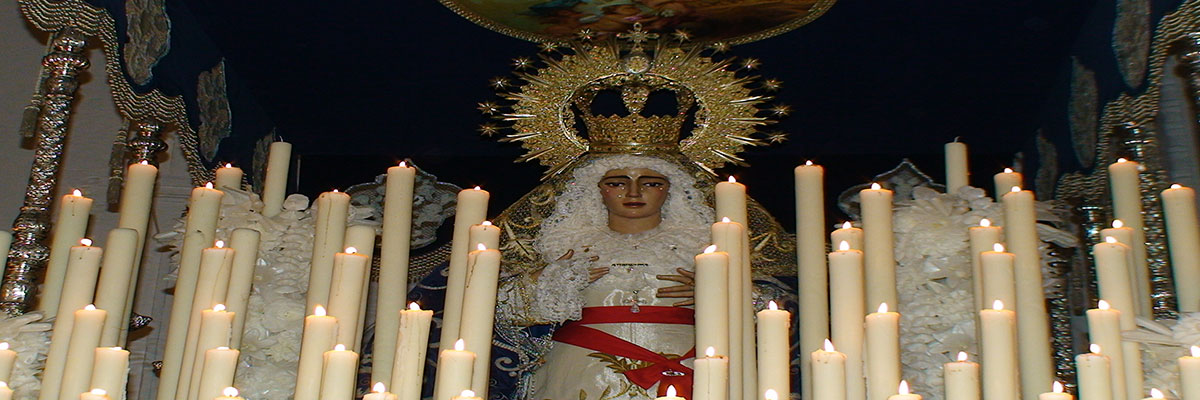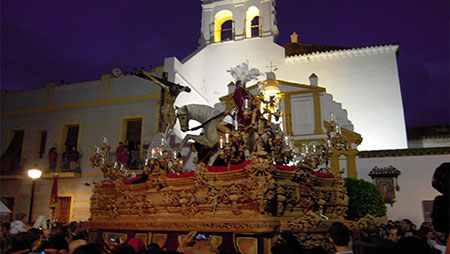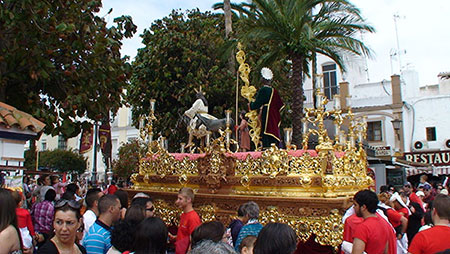"Ayamonte's busiest week of the year"

Semana Santa, Easter week is the most important week in the Catholic calendar more so than Christmas. In Spain with a predominant Catholic population the celebration in religious terms takes to the streets in the form of processions.
There are many famous processions throughout Spain, but there are always four which almost any Spanish person will name when asked and they are Valladolid, Zamora, Málaga and Seville.
Each of these famous cities have their own particular way of celebrating Easter, but for simple climatic reasons the processions in Andalucía have a more numerous following in both people within the procession and those watching on.
Viewing a procession for the first time, whether you are Catholic or not, is an experience that you will never forget. I recall seeing my first procession in 1995 in Valladolid and there the processions are carried out in a more sober fashion and people watch on in almost complete silence. Andalucía on the other hand is completely different with more bands leading the processions and the spectators applauding and screaming out compliments as a throne passes.
Seville is known as the oven of Spain but it is during Easter week it transforms itself into something special that the words that I am about to write below will never do justice. The phrase “you have to be there to understand” is the perfect explanation for Seville in Semana Santa.
The sound of thousands of people moving in unison, the flickering light given off by hundreds of candles carefully placed around a religious image, the strong waft of incense which seems to penetrate your nostrils coupled with the sweet smell of candle wax and thousands of flowers, the lift of hundreds of kilos in weight in one clean movement by the costaleros, the shear skill of manoeuvring these immense thrones ,with their invaluable works of art, through the narrow streets of Seville and the solitary sound of a flamenco singer who perched on a balcony sings a Saeta to the passing procession as if their very life depended on it. An experience to be lived and not read about!
No sooner has Christmas finished and the Hermandades / Cofradías are practicing for the processions for Semana Santa, Easter week which in 2013 is from Palm Sunday March 24 to Easter/ Resurrection Sunday March 31.
First of all, I would like to introduce some of the words that are part and parcel of Semana Santa.
Cofradías / Hermandades: These are religious brotherhoods to which each person in the procession belongs and each brotherhood has their own distinctive dress or emblem.
Costalero: These are the people who carry the thrones or religious images during the procession.
Nazarenos: These are members of the brotherhoods who parade in front of the thrones normally dressed in a tunic, cape and capirote or cucchurcho
Capirote or Cucurucho: The pointed hats worn by the Nazarenos which cover the face with only two holes for the eyes. The shape is very much like a dunce’s cap and the expression “ser tonto de capirote” an utter fool is also used in Spanish.
 Saeta: a religious song which originates from when nuns in convents in 16th Century sung to the passing processions, but in late 1800’s was adapted by flamenco singers to the form in which it exists today.
Saeta: a religious song which originates from when nuns in convents in 16th Century sung to the passing processions, but in late 1800’s was adapted by flamenco singers to the form in which it exists today.
The processions only take place if there is no rain, as the works of art that are carried by the costaleros are invaluable. Should it start to rain while a procession is in progress, the works of art take refuge in the nearest church. Luckily the weather in the South of Spain is normally good, but when it does rain it is not uncommon to see grown men weep in frustration as their brotherhood is denied the chance to carry their thrones to the city of Seville.
Semana Santa in Ayamonte
Ayamonte with its narrow cobble streets and effigies built on thrones that are hoisted high by the Costaleros , members of the religious brotherhood who carry the effigies on their shoulders, also has something very special. The dedication, the skill and sheer effort to carry all that weight for hours is enough to gain the respect from any spectator. On occasions they only have millimetres to manoeuvre the thrones and remembering that these effigies are centuries old and of incalculable value, it only adds to the occasion.
Here is the breakdown of the brotherhoods involved in the processions in Ayamonte,please note that the bands stated are subject to change as this is the 2010 program.
Palm Sunday:
Hermandad del Señor Triunfante en su entrada en Jerusalén, Cristo Amor y Nuestra Señora de la Salud. Founded in 1918.
Cristo Amor , dating from XVIII century ( purple iris)
Virgen de la Salud ,1943, (iris & white roses)
Señor Triunfante, 1943, ( red carnations)
Holy Monday
Real Hermandad de Jesús Cautivo, Cristo de la Buena Muerte y Maria Santisima del Rosario. Founded in 1971
Jesús Cautivo, 1973, (red carnations), accompanied by Cristo de la Buena Muerte band.
Cristo de la Buena Muerte, dating from XVI century (Blue-bird rose of sharon) accompanied by Cornet & Tambor Ntra. Sra. del Rosario Band.
Virgen de la Rosario, 1972, (Ivory coloured roses)
Holy Tuesday
Real, Antigua, ilustre Y Fervorosa Hermandad y Cofradía de Nazarenos de la Sagrada Lanzada y Maria Santísima de la Esperanza del Mar. Founded in 1918.
Sagrada Lanzada, ( red roses & carnations)
Holy Wednesday
Hermandad y Cofradía del Santísimo Cristo de la Victoria, Nuestro Padre Jesús de la Pasión y Maria Santísima de la Paz. Founded in 1940.
Padre Jesús de la Pasión, 1942, (red carnations) accompanied by Cornet & Tambor Virgen de la Salud band ( Huelva)
Maria Santísima de la Paz, ( white carnations) accompanied by Ntra. Snra. de la Soledad Band (Sevilla)
Holy Thursday
Real, Ilustre y Muy Antigua Hermandad Sacramental del Salvador 1718 y Cofradía de Penitencia de la Oración en el Huerto 1918, Nuestro Padre Jesús Caído y Nuestra Señora de la Amargura.
Oracion en el Huerto, accompanied Cristo de la Buena Muerte band
Ntro. Padre Jesús Caído accompanied by Cornet & Tambor band ( Bilbao)
Ntra.Sra. de la Amargura accompanied by Cristo de Perdon band ( Seville)
Good Friday (Early Morning)
Cofradia de Nuestro Padre Jesús Nazareno Y Maria Santisima del Socorro founded between 1596 and 1604.
Nuestro Padre Jesús Nazareno, (red carnations)
Maria Santísima del Socorro, ( orquids )
This procession starts at 2am on Calle Galdames and ends at 10am in Capilla del Socorro. This procession does not have a musical band but it is the village people that accompany the Christ & Maria.
Good Friday
Pontificia, Real e Ilustre Hermandad Sacramental y Archicofradia de Nazarenos del Santo Entierro, Descendimiento de Cruz y Nuestra Señora del Mayor Dolor founded in 1892
Descendimiento de Cruz ,1948, accompanied by Cornet & Tambors Virgen de la Salud band ( Huelva)
Nuestra Señora del Mayor Dolor, 1942, accompanied by Villablanca Municipal band.
Good Friday
Muy Antigua, Real e Ilustre Hermandad Franciscana de Penitencia de la Vera Cruz, Santo Entierro de Cristo y Maria Santisima en su Soledad. Founded in 1550.
Cristo de la Vera Cruz, 1941, (purple iris), Cornet & Tambor band (Sevilla)
Cristo Yacente, XVI century, Bollullos del Condado Philharmonic band
Maria Santisima en su Soledad, 1937, (white flowers & bitter orange white flower)
Easter Sunday
Hermandad de Jesús Resucitado y Maria Santísima de la Victoria. Founded in 1990
Jesús Resucitado, 1991, (red carnations) accompanied by Cornet & Tambor band.
Maria Santísima de la Victoria, 1996, (red roses & carnations) accompanied by Maestro Tejera band ( Seville)